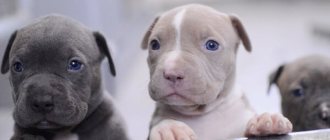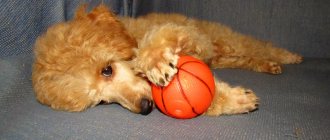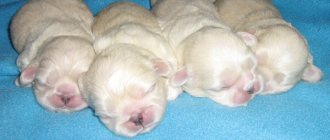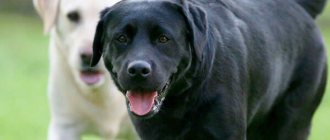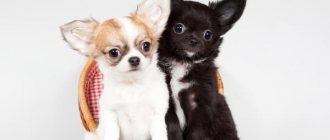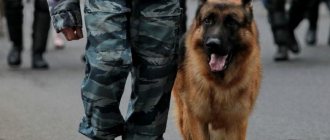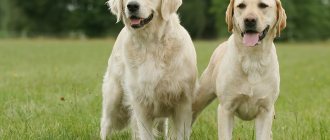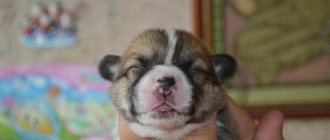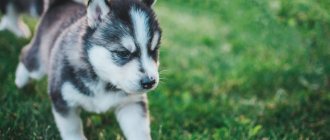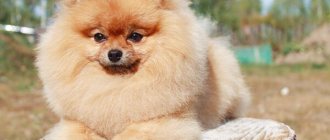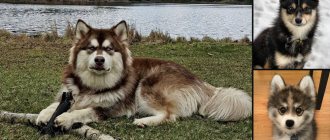One of the most loyal and kind dog breeds is the Labrador Retriever.
Dogs of this breed are distinguished by their intelligence and friendliness.
Thanks to these qualities, they are considered the best guide dogs.
Labrador gets along well with all family members: from children to the elderly.
Like all purebred dogs, Labradors should be purchased from a breeder to ensure the purity of the breed.
Photos of newborn puppies
Newborn Labrador Retriever puppies have ears and eyes initially closed; they are unable to regulate their body temperature on their own, so they must be kept in a warm room (do not keep them near a radiator or fireplace, this can harm them). Usually the mother provides the desired temperature, keeping the puppies warm.
Externally, the puppies already look like adult representatives of the breed, but they are a smaller copy of them, the muzzle is less pointed.
Puppies open their eyes at about 10 days, there may be delays up to 16 days.
At this age, thermoregulation begins to improve.
NOTE!
You should be careful, since it is during this period that the bitch’s hormonal levels change, which is why the puppy may have temporary digestive problems.
The weight of newborn puppies ranges from 400 to 550 g. Height at the withers is from 12 to 15 cm. Usually a bitch gives birth to up to 5-10 puppies.
Appearance and what it looks like in the photo
A six-month-old puppy no longer looks like the plush bun with which he came into the house; now he is a teenager, and already looks like an adult dog.
His paws become longer, his ears lag a little behind his head, the puppy loses weight and, accordingly, becomes less clumsy, the structure and quality of the coat changes.
Parameters
typical for a six-month-old Labrador :
- Weight - about 24-26 kilograms;
- Height at withers - about 50-55 cm;
- Chest circumference - about 67-70 cm;
- Head circumference is about 42-43 cm.
Development by day in the first month
Every day after the puppy is born, there is an increase in weight. In the first month, approximately 100-150 g per day.
From days 1 to 14, newborn puppies can only crawl and suckle at their mother's breast, gradually their sense of smell develops, and they independently try to find their mother.
It is necessary to closely monitor the puppies' temperature and avoid hypothermia when the body temperature drops to 34 degrees Celsius. If the puppies have a low temperature, they should be warmed up immediately on your chest. This method is the most effective and correct.
From 15 to 30 days, puppies open their eyes, a noticeable reaction to light, sounds, and nearby movement. At this time, animals begin to go to the toilet on their own and their teeth are cut. Dogs are becoming more and more active, starting to crawl and even run.
From days 21 to 30, the puppy begins to recognize the people around him. During this period, you need to especially carefully protect the puppy’s safety: it is forbidden to make loud noises, as this can negatively affect the pet’s condition. During this period, small Labradors learn the behavioral patterns of dogs.
Groundbait is introduced, which can cause small Labradors to experience diarrhea; this is a normal phenomenon, as they find it difficult to tolerate changes in diet. This should not be a cause for concern as long as the color and smell of the discharge does not change.
IMPORTANT!
If there are changes in the smell and color of the discharge, treatment must be started immediately. For this purpose, special medications are suitable to help normalize the functioning of the gastrointestinal tract.
What affects a puppy’s parameters
How much an adult male or female Labrador weighs is influenced, first of all, by intrauterine development and the suckling stage of life. Did the pregnant bitch receive all the necessary vitamins and minerals from her diet, and were there any pathologies in her embryos? These factors lay the foundation for the development of future puppies.
Labrador's heat: how long does it last for the first time?
From birth, boys are larger than girls. If the opposite trend is observed, such a dog requires special attention. It is recommended to provide additional supplementary feeding.
Important! Puppies that are lagging behind in development and weight gain must be checked for infectious diseases and congenital abnormalities.
With a small pregnancy, puppies are born larger than with a multiple pregnancy. And with early and proper complementary feeding, small Labradors will grow and develop faster.
The quality of development of puppies is influenced by three main factors:
- animal's lifestyle;
- proper nutrition;
- physical activity.
The optimal ratio of a puppy's body weight and height can be achieved by providing him with a properly balanced diet and providing the necessary conditions for keeping him. These are the main factors for a puppy under 8 months of age. Along with them are regular treatments against all parasites.
Active walk with Labrador
Until six months of age, special attention should be paid to the development of the animal’s skeletal system. If she lags behind in development, this threatens the development of osteochondrosis or rickets. It is not possible to correct these shortcomings in a dog after 6-8 months.
The growth of puppies, in particular Labradors, is characterized by spasmodic growth. During each stage, certain parts of the body actively grow. Thus, with short legs, increased growth of the body occurs; with narrow proportions, the puppy grows upward. No need to worry about this.
Important! The puppy will acquire the correct features corresponding to the breed standard closer to one year.
Growth from 1 to 12 months
The first year of a Labrador’s life deserves special attention:
| Age | Weight | Height | Description |
| 1 month | 3.4-4.8 kg | 23-32.5 | A wet and cold nose, an elastic belly, a uniform coat color, a tail similar to that of an otter. The one-month-old puppy is playful and active. |
| 2 months | 7-8 kg | 30-32.5 | At this age, the baby feels comfortable away from his mother and other puppies. Baby teeth begin to develop. |
| 3 months | 12-14 kg | 39.5-42 | It grows actively and becomes restless. From the moment of birth, growth triples. |
| 4 months | 17-19 kg | 44-46 | An awkward body, the so-called teenage period. Teeth begin to cut. The differences between females and males are visible. |
| 5 months | 21-22 kg | 48-51 | The paws lengthen, the puppy becomes stronger. Teeth change. In male dogs, the testicles droop. |
| 6 months | 24-26 kg | 50-55 | The puppy must know all commands and obey easily. Getting used to using the toilet outside the home. |
| 7 months | 26-28 kg | 52-56 | Puberty is reached. All the teeth have already changed. |
| 8 months | 28-30 kg | 54-57 | Bitches are ready for heat and can begin to mark their territory. |
| 9 months | 30-32 kg | 54-58 | The last stage of growing up occurs. The weight reaches its typical level (for females 27 kg, for males 30 kg). |
| 10 months | 32-34 kg | 54-58 | The puppy looks like an adult, its physique is completely formed. |
| 11 months | 34-36 kg | 54-60 | The dog stops growing. |
| 12 months | 30-38 kg | 54-61 | Puppies finally take on the appearance of adult dogs. Powerful and strong paws, short tail, thickened at the base. |
The growth of Labrador puppies depends on genetics, but full maturity is achieved at the age of 12 months.
Appearance and characteristics of puppies
A Labrador puppy at 3 months looks like a fairly large animal; it is already a teenager with strong paws and molars that are beginning to erupt, replacing milk teeth. Healthy babies have a well-fed body, but without signs of excess weight, and are covered with beautiful, shiny and smooth hair.
If the puppy is purebred and healthy, then he has:
- medium-length, dense limbs;
- hanging ears;
- moderately massive head;
- straight back with strong bones;
- tucked belly;
- the color is uniform throughout the body, without flaws, colored or white spots;
- straight nose;
- medium width withers;
- sufficient distance between the hind and front legs;
- moderate length tail.
A similar breed of hunting dog, the Labrador Retriever may have a narrower, more graceful muzzle, longer coat, and brighter colored coats ranging from gilded to gold.
A three-month-old Labrador is active, inquisitive, and reasonable balance prevails in his character, with the exception of games, when, when carried away, he can growl and bark.
However, this is only temperament, not aggression.
Common parameters:
- height at the withers – 40–42 cm;
- head circumference – 34–36 cm;
- chest circumference – 50–56 cm;
- muzzle length – 6–7 cm;
- muzzle circumference – 22–24 cm;
- mouth girth – from 11 to 11.5 cm.
At three months, the puppy should weigh about 12–14 kg, with the weight of girls being closer to the lower limit of the standard.
The lack of pure blood in a puppy can be indicated by: a belly lowered to the ground, limbs that are too long or disproportionately short, clubfoot and squint, and a semi-erect appearance of the ears. Also, healthy young animals practically do not have dental diseases.
Basic care rules
When caring for a Labrador puppy, you must follow several rules:
- Monitor his body temperature (several degrees above the environment, but not less than 35 degrees).
- Monitor the puppy's weight and feeding (every hour and a half, it is best if the mother is constantly with the puppies).
- If you are underweight, you should intervene and start feeding them or check the condition of the gastrointestinal tract and start treatment in a timely manner.
- When teeth begin to erupt, give him the opportunity to chew on something.
- Monitor your puppy's stool (color, smell, consistency).
- Training (starts at 2-3 months).
- Hair care (constant combing, keeping clean).
- Timely vaccination (puppies are not protected from all diseases, so vaccination is one of the most important stages; this should be done at the age of 16 weeks).
Exercise stress
Labrador is an active and lively dog; puppies of this breed grow quickly, and in order for the baby to develop normally, he needs to walk for at least two hours every day, and also visit the training area.
If there is insufficient load, a growing baby Labrador, like a Cane Corso puppy , begins to spoil and chew things, make tunnels, and dig holes in the yard.
The ebullient energy must be given an outlet, but it is impossible to overload the Labrador by jogging behind the bicycle.
Willy-nilly, you smile while looking at a happy Labrador puppy running
A four-month-old puppy can already visit the training area and walk with the owner for an hour or two.
It is useful to walk up the stairs or up the mountain (but go down either by another route, or carry your Labrador in your arms).
Swimming in open water, running in shallow water - all this is very popular with Labrador babies, it strengthens their muscles and promotes proper development.
Why does my puppy urinate frequently?
Newborn Labrador puppies cannot defecate on their own, so their mother licks them to stimulate the discharge.
This reflex can remain with the puppy even as he begins to mature. This is due to the fact that he does not yet have full control of his bladder.
This should go away over time, but if the owners notice unusual behavior in the puppy, this may indicate a disorder. Mostly, frequent urination can be a result of fear or stress.
The only thing that can be done in such a situation, when the puppy urinates frequently, is to contact a veterinarian, who will identify the cause of the behavior and prescribe medications, or send the pet to a canine psychologist.
Feeding with natural food
If the owner chooses to feed the puppy natural food, then it is worth considering that food from the human table is not suitable; it must be prepared separately for the dog. The issue of diet planning must be approached very responsibly.
The daily amount of natural food for a six-month-old Labrador is 3-4% of its weight.
Three feedings per day are recommended. Nutrition components are distributed approximately as follows: 3/5 – meat, 1/5 – vegetables and fruits, 1/5 – cereals, 1/5 – fermented milk products.
Puppy meat should be frozen first and then cut into pieces. By-products, incl. and liver must be boiled. Jellied meat made from beef bones is very useful for puppies.
For better absorption of vegetables, you need to add any vegetable oil to them..
As treats, puppies can be given rye crackers, cheese, apples, and carrots.
It should be noted that Labradors are terrible gluttons and are always ready to beg for food, especially if it is the owner’s food.
Therefore, we need to know about a number of foods that should not be given to a dog: milk, sweets, pasta, bread, legumes, potatoes, sugar, spices, onions, garlic, radishes, grapes, raisins, salted, smoked, fried, fatty meat, tubular bones.
All this, to one degree or another, harms the puppy’s health.
Natural feeding cannot fully saturate the puppy’s body with all the necessary substances, so some supplements need to be introduced.
Since the Labrador is a large and heavy dog, it is necessary to support the puppy’s joints and bones; for this, chondroprotectors and calcium should be added to its diet.
If the dog refuses oil in its food, then vitamin A must be administered.
Sample puppy menu:
| Breakfast | Dinner | Dinner | |
| Monday | Low-fat cottage cheese + kefir | Beef+rice | By-products (heart, kidneys, udder, lung) + salad (pumpkin, zucchini, carrots, greens, beets, cabbage, apples - to choose from) + oil |
| Tuesday | Low-fat cottage cheese + sour cream | By-products (heart, kidneys, udder, lung - to choose from) + buckwheat porridge | Beef+salad+butter |
| Wednesday | Low-fat cottage cheese + bifidok | Liver + wheat porridge | Liver+salad+oil |
| Thursday | Low-fat cottage cheese + kefir + egg | Turkey+oatmeal | Offal+salad+oil |
| Friday | Low-fat cottage cheese + sour cream | Beef+buckwheat | Turkey+salad+butter |
| Saturday | Low-fat cottage cheese + yogurt | Offal+rice | Beef+salad+butter |
| Sunday | Low-fat cottage cheese + yogurt | Lean sea fish + rice + buckwheat | Fish+salad+oil |
Dry food
Balanced food ensures harmonious growth and development of the dog’s skeleton, teeth, muscles, and excellent coat condition.
Therefore, it is worth completely eliminating cheap mass market products, such as, for example, Pedigree, Chappie, etc..
Such economy class food does not meet the needs of a growing puppy’s body. It is worth choosing premium and super premium food or holistic food, choosing something that suits the puppy and will not cause allergies, digestive problems, etc.
There are many brands of acceptable dry food, such as Hill's, Royal Canin, Eukanuba, Purina Pro Plan, Acana, etc.
IMPORTANT!
When choosing food, you should pay attention to the amount of protein and fat in it: high-protein food is not suitable for a Labrador puppy; the optimal content is 22-25%.
At 6 months the puppy is already eating according to the diet for juniors . The optimal number of feedings per day is 4.
Each food package indicates the age category and a table with the consumption rate, which is calculated based on the weight and age of the puppy. But it is not an immutable truth; you should focus on your dog.
A Labrador puppy should not be too thin, but not too fat either . Excess weight is very harmful to a dog's health.
If the dog is overweight, he will have to be temporarily switched to light diet food or reduce the amount of regular food.
Often Labradors are allergic to one or another food . It can manifest itself as redness in the ears, skin rashes, and itching. In this case, you need to consult a doctor and temporarily switch to hypoallergenic food.
When deciding to feed a puppy dry food, porridge, meat, and dairy products are strictly prohibited in the diet, because... the addition of protein will upset the balance of nutrients, which can lead to kidney and liver diseases.
You can give fruits and vegetables as treats.
Feeding dry food increases your dog's need to drink, so be sure to keep the water bowl full at all times . It, unlike a bowl of food, should always be freely available to the puppy.
How to toilet train?
to toilet train your puppy as soon as he begins to move around and defecate on his own. Training takes place in 2 stages: home and street. First you need to teach your dog to relieve himself on a diaper or oilcloth.
CAREFULLY!
It is dangerous for an unvaccinated dog to walk outside the home, as the risk of disease increases significantly.
At first, you need to carefully monitor your pet’s behavior. Typically, bowel movement occurs immediately after sleep or immediately after feeding. As soon as the puppy begins to walk restlessly and sniff, the owners should help him do his business in the right place. This should be a signal of readiness.
Under no circumstances should you scream or hit your pet for urinating in the wrong place. The puppy is still small and just learning, and shouting and violence can harm him both physically and psychologically. The owner should be a protector and friend, not a tyrant.
You should definitely praise your pet for doing things where necessary and even reward him with a treat.
Don’t be surprised if the puppy manages to leave a puddle overnight. He simply does not know how to endure; this skill will appear only with age.
The second stage is not much different from the first. All the same machinations must be carried out on the street. There is no need to be shy about praising your dog and showing sincere joy when it successfully goes to the toilet; this will only be beneficial.
When walking a dog (for the purpose of toilet training on the street), you need to try to protect it from distractions: people, cars, other animals.
Features of the breed that are taken into account when feeding
When compiling a menu for a Labrador, specific breed characteristics are also taken into account.
Gluttony.
These dogs are ready to eat endlessly. Even if the dog has just eaten a couple of bowls of meat, he will not refuse another pack or two of his favorite treats. Owners feel as if their pets are always hungry and overfeed the animals. Therefore, it is important to clearly define the daily amount of food (main feedings and snacks) and not deviate from it.
Labradors are prone to obesity
Prone to obesity, diabetes and hip dysplasia.
This is a vicious circle: Labradors are genetically predisposed to excess weight, which leads to problems with the musculoskeletal system and the thyroid gland. It is difficult for an already sick dog to lose weight. So it’s better to be strict and not give your dog his favorite cookies again than to stop the symptoms later.
Predisposition to food allergies.
New products or ready-made food are introduced gradually, carefully observing the reaction and condition of the animal. It is advisable to exclude common allergens from the diet: soy, corn, wheat, chicken, any food with chemical preservatives, dyes, etc.
Labradors often have cases of stomach and intestinal volvulus.
They cannot be walked immediately after eating - the pet needs to rest for 1-2 hours. It’s even better to take your pets outside before feeding.
Raising a healthy Labrador is not easy: you will have to carefully select the diet, calculate calorie content, strictly control nutrition and not give food in excess of the norm. But the effort is worth it: by adhering to proper feeding, you will get an active pet that is not familiar with diseases.
You may also be interested in:
- What is the difference between a Labrador and a Golden Retriever?
- DIY homemade treats for your pet
Nutrition in the first 3 months
The difficulty in keeping these pets in the first months lies not only in toilet training, but also in proper feeding. The digestive system of this breed is very delicate and reacts sharply to changes in diet. Therefore, this issue must be approached with all seriousness.
For the first month, the puppy feeds on mother's milk, but if there is a deficiency of calories and nutrients in it, the puppy may lose weight. In this case, you need to help him with additional nutrition.
At the age of up to 3 months, you need to pay special attention to the frequency and timing of feeding small puppies. The interval between meals is at least 1.5 hours, duration – no more than 20 minutes. You should not force feed the animal, but you should not allow it to be distracted while eating. If feeding turns into play and pampering, you need to stop it immediately.
NOTE!
You should always make sure there is water in your dog's bowl. It should always be clean and fresh, and the pet should have unlimited access to it. If you refuse to drink or feed, you should immediately consult a doctor. This may indicate serious illness.
It is best to start feeding with liquid cereals, since the pet is not able to chew food fully (teeth simply have not developed). Gradually, you can get used to dry food, which will be soaked in kefir or yogurt before feeding. To help the growing body cope with food, it is recommended to give your puppy prebiotics. This should also be done if you have loose stools.
Character of the breed
Labradors are very welcoming and friendly dogs. This characteristic of the Labrador Retriever makes the dogs treat strangers kindly.
Labradors will not bark or rush at strangers; rather, they will try to make friends faster. They are great companions. They get along well not only with children and people, but also with other animals.
Labradors are very smart and loyal. They understand people very well and are easy to train. Moreover, Labradors are very sensitive to the emotional background and sometimes even try to defuse the situation with their presence if they feel that the atmosphere is tense.
Labradors love their owners so much that when trained they are very obedient, just to please their person and bring him joy.
They treat children well and can even keep an eye on them while remaining a nanny. There are many stories of Labradors rescuing children in different situations.
How to feed a grown pet?
With each month, puppies need to reduce the number of feedings per day and increase portions.
First, you need to feed the dog 5-7 times a day and give it 300-350 grams of food per day. That is, about 50 grams per meal. At 3 months, the portion increases to 400-450 grams per day, and the number of feedings decreases to 4-5 times a day.
Sample menu for the week:
- Liquid oatmeal – 2 times a day. One boiled egg. Kefir.
- Liquid buckwheat with finely chopped boiled meat, yogurt, grated cabbage.
- Rice porridge in water, with the addition of a few drops of vegetable oil, fish, grated pumpkin.
- Buckwheat (can be made thicker), medium-chopped meat, grated potatoes (raw).
- Cottage cheese, oatmeal, pumpkin (grated), fish.
- Coarsely chopped meat, carrots (grated), raw yolk, rice porridge.
- Fresh herbs (added to the porridge), porridge at your discretion, meat, grated zucchini.
If necessary, you can include vitamins prescribed by a veterinarian and various nutritional supplements in the menu. You can also use homemade supplements.
Diet of grown and adult Labradors
Labradors from one year and older are fed twice a day. Approximately follow the following calculations:
- an adult dog per day requires a volume of food equal to 4% of the animal’s weight - about 0.7-1.4 kg of food daily;
- amount of meat – 15 g per kg of weight;
- daily carbohydrate intake – 5 g per kg;
- The daily fat requirement is 2 g per kg.
The total amount of food is divided into 2 meals: morning and evening. The second feeding should be more filling: meat, vegetables, cereals. The morning menu consists of easily digestible foods - cottage cheese, eggs, kefir.
In between main feedings, you can treat your Labrador with treats, fruits, and mineral supplements. Their calorie content is included in the daily intake.
Indicative menu:
- in the morning – cottage cheese or omelet, fresh vegetables;
- in the evening - chopped beef (fish) and offal with cereals, boiled vegetables, herbs.
The caloric content of an adult Labrador's diet is regulated individually for each dog.
The volume of portions and snacks depends on the activity of the animal: service or hunting dogs receive 15-30% more protein products than pets.
The gender of the animal also matters (males are given 7-15% more food) and the time of year (in summer the amount of food is reduced by 15%).
Which dry food to choose?
Several criteria for choosing the right dry food:
- the most important thing is that the puppy must like it;
- the pet should not be allergic to it or intolerant to the products present in the composition;
- availability;
- the price must be acceptable to the owner;
- quality.
It is best to avoid buying the cheapest food, as it may be of poor quality. For puppies, it is better to choose special food designed for early feeding. Royal Canin and NaturVet are considered popular dry foods.
Introducing complementary foods
The first complementary foods are given to puppies after teething. This is a soaked specialized dry food or homemade diet.
Both of these options have their pros and cons, and professional breeders differ in their preferences. Expert opinion
Tolkachev Andrey Mikhailovich
veterinarian
I do not consider ready-made balanced foods, because I believe that any artificial mixture differs from “live” natural products. And the point here is not in the composition or selection of certain ingredients. Ultimately, you can choose any composition of proteins, fats and carbohydrates with vitamins and microelements, but it is impossible to guarantee the biological activity of the components of a freeze-dried (canned) product and their corresponding effective absorption, digestibility and utilization.
The puppy should be active and cheerful, with a good appetite and regular bowel movements. Any changes in the animal’s well-being and behavior - lethargy, refusal to eat, nausea, vomiting, diarrhea - require consultation with a veterinarian!
Vaccination schedule and which ones should be done?
The table below shows which vaccinations are required for a Labrador by age:
| Name of the disease | Primary vaccination | Revaccination | Subsequent vaccinations | |
| First vaccination | Second vaccination | |||
| Rabies | 4 months | – | 12 months | Every year |
| Plague | 2-2.5 months | In 3-4 weeks | 12 months | Every year |
| Infectious hepatitis | 2-2.5 months | In 3-4 weeks | 12 months | Every year |
| Parvovirus enteritis | 2-2.5 months | In 3-4 weeks | 12 months | Every year |
| Canine parainfluenza | 2-2.5 months | In 3-4 weeks | 12 months | Every year |
| Leptospirosis | 2-2.5 months | In 3-4 weeks | 12 months | Every year |
| Trichophytosis | 1 month – six months | In 1.5-2 weeks | 12 months | Every year |
| Microsporia | 1 month – six months | In 1.5-2 weeks | 12 months | Every year |
Do I need to get vaccinated at this age?
At the age of 5.5 months, dogs usually finish changing their teeth. After this, it is necessary to give the puppy an anthelmintic, and after 14 days, vaccinate against plague, hepatitis, enteritis, leptospirosis, and rabies. After this, for 10 days you should not approach other people’s dogs, bathe or overcool the puppy.
Subsequently, vaccinations are given every year throughout the dog’s life, with preliminary deworming 14 days before vaccination.
How to bathe properly?
The next aspect, which is no less important when caring for a Labrador, is bathing. You should not bathe your pet often; do it only when absolutely necessary. Since the Labrador's coat repels water, it will be quite difficult to get your dog wet. You can bathe with or without shampoo.
Do not allow water or shampoo to get into your ears, eyes or mouth.
This breed loves to splash in the water, but they are not always able to endure the washing procedure.
Cleaning teeth, ears and trimming nails
First, you need to carefully examine your ears and teeth for inflammation or infections.
To clean your ears, you can use cotton wool, gauze, cotton pads, cotton swabs or special wipes.
You can brush your teeth yourself by wrapping your finger in gauze or a bandage, or with a special brush. You can also use teeth cleaning products purchased at a pet store.
As for trimming claws, if the owner does not have sufficient experience, it is better to contact a specialist. In any case, you need to buy special tweezers for cutting.
How to care for wool?
The coat of Labrador puppies is smooth and short, so it is not very difficult to maintain. It only needs to be combed 2-3 times a week with a special brush.
If your puppy has dandruff, you should contact your veterinarian. Many people advise increasing the humidity in the house or moisturizing the pet’s skin directly with special lotions. You can also try changing the food.
Frequent bathing can also lead to dandruff, however, washing with a special shampoo will not hurt.
What should natural food include?
How to feed a Labrador natural food if the dog does not like raw meat? In this case, you need to give boiled or steamed meat. It is important and necessary to give stringy pieces of meat so that your pet chews them.
Offal must be cooked thoroughly and for a long time. The stomach (tripe) is given to the dog raw - it is very healthy and is a delicacy made from offal.
Natural food must be freshly prepared. It can be from the refrigerator (no more than two days) and heated.
Advice! You should not give your pets cold or hot food - only warm or room temperature.
If the dog categorically does not eat any of the food offered for several days, then you need to replace this product with an analogue, or prepare a treat with your own hands.
Food for Labrador, necessary products in the diet:
- meat (beef, veal, lamb (remove fat), horse meat, rabbit, turkey);
- liver, kidneys, heart, stomach;
- vegetables (carrots, pumpkin, cauliflower, beets, zucchini, turnips);
- 1 raw potato per week;
- fruits - apples, pears, apricots;
- fresh greens, spinach, lettuce, onions, garlic;
- dairy products (kefir, sour cream, cottage cheese, yogurt);
- vegetable oil (ordinary, flaxseed or olive);
- fish (sea, boiled, boned);
- cereals (buckwheat, rice, oatmeal);
- cartilaginous bones;
- eggs (once a week - in the form of an omelet or boiled);
- water (always keep it fresh).
Prohibited products:
- sausage, frankfurters;
- smoked, fried foods;
- sweet, salty, hot seasonings;
- pasta and legumes;
- lamb with fat, pork;
- bones – a dog may choke or swallow a sharp bone, causing intestinal ruptures;
- corn;
- milk (in adult dogs it causes diarrhea);
- baking (causes bloating).
Advice! The Labrador is a large dog, so you need to be careful what food you leave on the table unattended. Do not leave anything harmful or dangerous to your pet's health there.
How to train and what commands to teach?
Training a puppy involves teaching basic commands:
- place;
- to me;
- ugh;
- sit;
- lie;
- give me your paw;
- voice;
- stand;
- fetch;
- front;
- near.
The dog learns each command only through encouragement; under no circumstances should you use physical force or shout. You should start with a nickname and leash training.
Training at home
There are more than 100 commands that a dog can remember. But it is enough for a pet to know the basic tricks. It is advisable when he turns 6 months old, then he should begin complex training.
Sit
This is the most common exercise. The Labrador quickly masters this trick:
- All you have to do is hold the cookie to your pet’s nose. With this approach, the dog will definitely sit. It is important to say the word “sit” so that the dog can learn the process.
- The exercise should be repeated several times so that the puppy can fully understand what is required of him.
- Training can be done before feeding, holding the food in front of the muzzle. The puppy will definitely get used to it.
In addition to cookies, the Labrador should also receive praise.
Lie
Training a puppy to do this trick is a little more difficult. Training process:
- The exercise is done in a standing dog position. Some argue that it is possible to train a child to carry out a command while sitting, but this cannot be done. You need to present the cookie to the puppy's face and place your hand on the back. Next, the command is pronounced and gradually, with light pressure, you need to lower the animal to the ground. Then a treat is given.
- It is after the exercise is completed that encouragement is given. The dog may offer resistance, but you must continue to apply pressure in the area of the shoulder blades.
- This is done until the Labrador accepts the reward in a lying position.
After this, the dog must say a command, and it must take a lying position from its place. Cookies should be replaced with moral encouragement.
To me
This command should definitely be taught to the dog. This helps in the walking process to recall the Labrador from prohibited places. How it's done:
- The exercise is imposed from the first days of the appearance of a small Labrador in the house. The nickname and the command “come to me” are pronounced. The puppy will quickly develop such a reflex.
- You can call your dog anywhere. For example: a Labrador is walking around the yard and you can call him. The dog will come running. A treat should be given for merit.
- Sometimes the puppy does not immediately run up and does not notice the owner. In this case, it is recommended to move away a couple of tens of meters and repeat the command or jump so that you can see it.
- Over time, the dog will begin to understand that when he says “come”, the owner will definitely thank him.
All commands must be pronounced after the nickname, for example: “Mukhtar, lie down.” There are no official instructions on how to raise a girl Labrador, so training is no different from a boy.
Useful materials:
- Cutaneous horn General description of the disease Cutaneous horn on the forehead or face (ICD 10 code - L57.0) -...
- Papillomas in dogs photo How to notice papillomaIf the virus entered the body of a dog with good health and good living conditions,…
- Itching and odorless discharge Main causesBefore considering the factors that provoke the appearance of discharge that has a sour odor, it is necessary to immediately note...
- Normal temperature in animals Normal temperature in different types of animals Veterinary services Day hospital for animals Veterinary certificates Vaccination…
Popular nicknames
The question of what to name a puppy should be taken seriously. The name should be simple and suitable for the pet.
The following nicknames are suitable for male Labrador puppies:
- Tyson;
- Jack;
- Bonya;
- Caesar;
- Rex;
- Hachiko;
- Graph;
- Baby;
- Ricci.
The girl can be called by the following names:
- Jaycee;
- Alma;
- Lucky;
- Bagheera;
- Gerda;
- Jesse;
- Nika;
- Eve.
Useful video
From the video you will learn what a Labrador puppy looks like at 3 months:
Rate the author's article:
3 ratings, average: 5.00 out of 5
Loading…
The Labrador breed is one of the most popular and beloved. There is a simple explanation for this - the dog has all the necessary service and wonderful personal qualities, it is friendly, cheerful, flexible, and amenable to training. This is a cheerful and faithful assistant to a person in all matters, but in order to raise and raise a puppy, you will need to learn everything about the characteristics of the animal.
How to choose your future pet?
Choosing a Labrador puppy depends on personal preference. You can choose between a boy and a girl, color and character. It is necessary to observe the behavior of the puppy and its parents, make sure that the breed is pure and has a passport. You need to make sure that neither of the parents has or is sick with anything, as this could be passed on to the puppy.
IMPORTANT!
The most important thing when choosing a puppy is the realization that you are acquiring a new family member who needs affection and care. You will need to monitor his health, hygiene and mood, as well as educate him. In the future he will become the most devoted friend and protector.
Training and education
Labradors are easy to train. The behavior of the puppy directly depends on the owner - the leader of the pack, who dictates the rules. Punishment for an offense is accepted if it follows immediately after the action. Correct execution of the command is immediately rewarded.
The puppy is taught that the owner has the right to a toy and food . Any aggression towards a family member must be stopped.
Some time after sleeping, eating or playing, the puppy is taken outside, teaching him to relieve himself outside the house. Until the puppy has learned to control his body, scolding him for puddles is useless.
If you adhere to the rules, then gradually the dog will begin to ask to go outside on its own, for which you need to praise.
During a walk, immediately stop attempts to tug on the leash with a jerk and the command “near!”, and after a few meters the command “walk” is accompanied by freedom for the length of the leash.
At home, the puppy is taught not to bark for no reason, not to climb on the bed, and not to take food outside the bowl.
At 3 months, the puppy should know his name and master the following commands :
- "Ugh!";
- "Place!";
- "Lie!";
- "Sit";
- "Near!";
- "Go for a walk."
Every year there are more and more fans of Labradors all over the world.
The breed is particularly loyal, flexible, kind and trainable . These dogs have practically no negative qualities, while combining a huge number of advantages.
